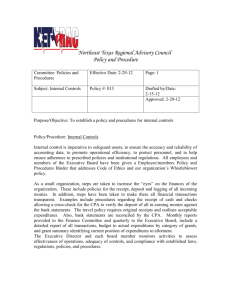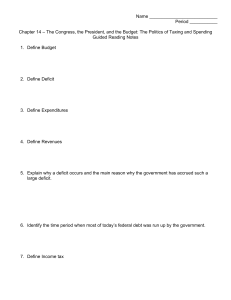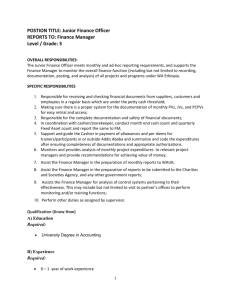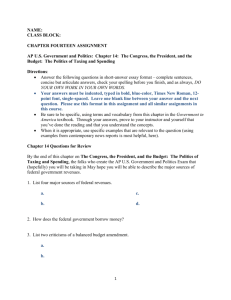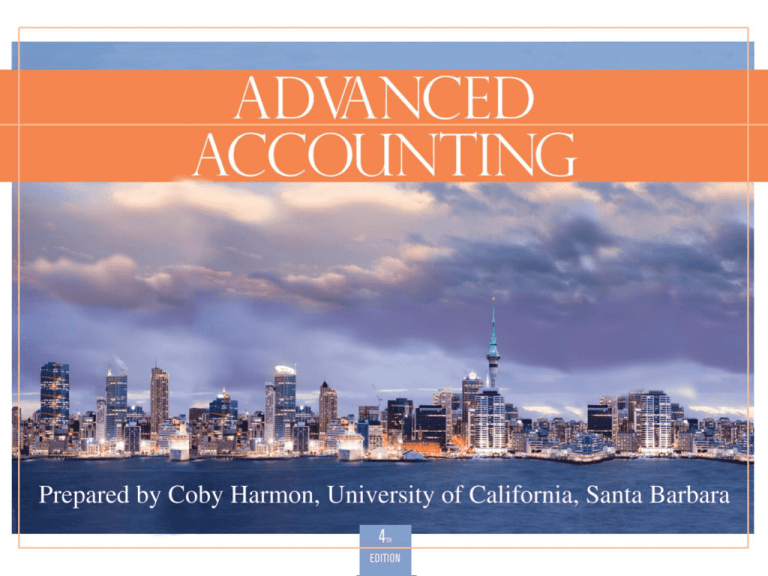
Slide
17-1
17
Introduction
to Fund Accounting
Advanced Accounting, Fourth Edition
Slide
17-2
Fund Accounting
Fund Accounting
Accounting for nonbusiness
organizations.
Nonbusiness
Organizations
Provide socially desirable
service without regard to
financial gain.
Slide
17-3
Business
Enterprises
Earn a return on
investment.
Competitive market.
Liquidity concerns.
Classification of Nonbusiness Organizations
Five Major Classifications
1. Governmental units.
2. Hospitals and other health care providers.
3. Colleges and universities.
4. Voluntary health and welfare organizations.
5. Other nonbusiness organizations (trade
associations, professional associations, museums, religious
organizations, etc.)
Slide
17-4
Distinctions between Nonbusiness
Organizations and Profit-Oriented Enterprises
Distinctions
Absence of primary goal to earn a profit.
No equity interests.
Seldom finance through user charges.
Rely on political action or fund-raising campaigns.
Income determination model generally not applicable.
Restrictions or limitations on use of resources.
Slide
17-5
LO 1 Nonbusiness organizations versus profit-oriented enterprises.
Fund Accounting
Fund Entity Classification
Expendable – Basic fund accounting concepts.
Proprietary – Business type activity.
Fiduciary - Agent or trustee.
Slide
17-6
LO 2 The role of fund accounting.
Fund Accounting
Expendable Fund Entities
Financial resources dedicated to a specified use.
Examples - Capital Projects or Debt Service fund.
Resources consist of cash and claims to cash.
Resources - Claims against resources = Fund balance.
Measurement focus is on flow of current financial
resources.
Accounting
Model
Slide
17-7
LO 3 Differences in applications of revenue, expense, and expenditures.
Fund Accounting
Proprietary Fund Entities
Activities that are similar to business enterprises.
Examples:
Electric or water utility by a municipality
Rental of real estate by religious organization.
Focus on determination of net income, financial
position, and cash flows.
Slide
17-8
LO 3 Differences in applications of revenue, expense, and expenditures.
Fund Accounting
Fiduciary Fund Entities
Trust and Agency funds:
Pension trust fund.
Agency fund (resources of taxes, bonds, and other
receipts held for individuals, outside organizations,
and/or other funds).
Slide
17-9
LO 3 Differences in applications of revenue, expense, and expenditures.
Fund Accounting
Budgetary Fund Entities (Governmental Funds)
Approved resource flows are incorporated into
annual budgets.
Budgeted expenditures are referred to as
appropriations.
Approved budget may be recorded in the
accounting records.
Budgetary account integration is useful in the
control and administration of fund resources.
Slide
17-10
LO 3 Differences in applications of revenue, expense, and expenditures.
Fund Accounting
Basis of Accounting
Basic Financial Statements
Government-Wide
Nonfiduciary activities.
Short- and long-run
information.
Current financial resources
concept.
Economic resources
measurement concept.
Modified accrual basis of
accounting.
Accrual basis of
accounting.
Revenues recognized when
measurable and available.
Expenditures recorded when
liability is incurred.
Slide
17-11
Governmental Fund (expendable)
LO 3 Differences in applications of revenue, expense, and expenditures.
Fund Accounting
Question
When used in fund accounting, the term “fund” usually
refers to
a. A sum of money designated for a special purpose.
b. A liability to other governmental units.
c. The equity of a municipality in its own assets.
d. A fiscal and accounting entity having a set of selfbalancing accounts.
Slide
17-12
LO 3 Differences in applications of revenue, expense, and expenditures.
Fund Accounting
Classification of Revenues
By Fund and Major Revenue Source
Major Sources of Revenue
Property taxes
Income taxes
Sales and excise taxes
Gift and inheritance taxes
Fines and penalties
Gifts and donations
Forfeits
Licenses and permits
Slide
17-13
Sales of property
Charges for services
Interest earned on loans and
investments
From federal, state, or local units:
Grants
Shared revenues
Payments in lieu of taxes
LO 4 Classification of revenues.
Fund Accounting
Other Financing Sources
Debt issue proceeds are accounted for as “other
financing sources.”
Interfund operating transfers are accounted for as
“other financing sources,” or “uses.”
Slide
17-14
Fund Accounting
Recognition of Revenue (Expendable Funds)
Revenue is ordinarily not recognized until it
1) can be objectively measured and
2) is available for expenditures of current period.
Slide
17-15
Fund Accounting
Recognition of Revenue (Expendable Funds)
Revenue recognized when measurable and available.
When Recognized?
Property Taxes
Income Tax and Sales Tax
Slide
17-16
Levied
Returns are filed with payment
Fines and Forfeits
Collected
Sales of Property
Time of sale
Pledges
Time of pledge
Grants
May or may not at time authorized
Fund Accounting
Recognition of Expenditures
Appropriation
Encumbrance
Expenditure
Authorized to
Spend
Purchase Order
or Contract
Receipt of Goods
Encumbrances and expenditures
are classified on the same basis
(by fund, function, organizational
unit, activity, character, or
object class) as appropriations.
Slide
17-17
Disbursement
Payment
LO 5 Classification of expenditures.
Fund Accounting
Question
Authority granted by a legislative body to make
expenditures and to incur obligations during a fiscal
year is the definition of an
a. Appropriation.
b. Authorization.
c. Encumbrance.
d. Expenditure.
Slide
17-18
LO 3 Differences in applications of revenue, expense, and expenditures.
Fund Accounting
Exercise 17-3: (partial) Listed are transactions of the
Town of Jackson.
1. A contract was signed with an independent company to
do the trash collecting for the year. The contract
price was $96,000.
2. The first monthly bill of $8,000 was received from
the trash collector.
3. The $8,000 bill was paid.
Required: Prepare the journal entries needed in the
records of the General Fund for these transactions.
Slide
17-19
LO 5 Classification of expenditures.
Fund Accounting
Exercise 17-3: 1. A contract was signed with an
independent company to do the trash collecting for the
year. The contract price was $96,000.
1.
Encumbrance
96,000
Reserve for Encumbrances
Slide
17-20
96,000
LO 5 Classification of expenditures.
Fund Accounting
Exercise 17-3: 2. The first monthly bill of $8,000 was
received from trash collector. 3. The $8,000 bill was paid.
2.
Expenditures
8,000
Contracts payable
Reserve for Encumbrances
8,000
8,000
Encumbrance
3.
Contracts payable
Cash
Slide
17-21
8,000
8,000
8,000
LO 5 Classification of expenditures.
Fund Accounting
Question
What type of account is used to earmark the fund
balance to liquidate the contingent obligations of
goods ordered but not yet received?
a. Appropriations.
b. Encumbrances.
c. Obligations.
d. Reserve for encumbrances.
Slide
17-22
LO 3 Differences in applications of revenue, expense, and expenditures.
Fund Accounting
Capital Expenditures (Expendable Fund)
Treated as a current period expenditure.
Middletown purchased a police car for $10,000.
Expenditures
Cash
Slide
17-23
10,000
10,000
LO 7 Capital expenditures.
Fund Accounting
Recording Budgeted and Actual Revenue and Expenditures
Exercise 17-3: (partial)
1.
A budget consisting of estimated revenues of $1,950,000 and
appropriations for expenditures of $1,800,000 was passed by
the town council.
2. Property taxes of $1,150,000 were assessed; $1,115,000 are
expected to be collectible.
3. Property taxes in the amount of $1,080,000 were collected.
4. Equipment costing $200,000 was purchased, and the old
equipment was sold at for $24,000.
Required: Prepare required journal entries for General Fund.
Slide
17-24
Fund Accounting
Exercise 17-3: 1. A budget consisting of estimated
revenues of $1,950,000 and appropriations for expenditures
of $1,800,000 was passed by the town council.
1.
Estimated Revenues
Appropriations
Unreserved Fund Balance
Slide
17-25
1,950,000
1,800,000
150,000
Fund Accounting
Exercise 17-3: 2. Property taxes of $1,150,000 were
assessed; $1,115,000 are expected to be collectible.
3. Property taxes of $1,080,000 were collected.
2.
Property Tax Receivable
1,150,000
Estimated Uncollectible Taxes
Revenue
3.
Cash
Property Tax Receivable
Slide
17-26
35,000
1,115,000
1,080,000
1,080,000
Fund Accounting
Exercise 17-3: 4. Equipment costing $200,000 was
purchased, and the old equipment was sold at for $24,000.
4.
Expenditures
200,000
Cash
Cash
Revenue
Slide
17-27
200,000
24,000
24,000
Fund Accounting
Exercise 17-5 (variation): The preclosing trial balance for the General
Fund of the City of Springfield is presented below.
Trial Balance for December 31, 2008:
Cash
90,000
Certificates of Deposit
120,000
Property Taxes Receivable
175,000
Estimated Revenue
1,690,000
Expenditures
1,310,000
Encumbrances
165,000
$51,000
Estimated Uncollectible Taxes
Vouchers Payable
65,000
Unreserved Fund Balance
44,000
165,000
Reserve for Encumbrances
Appropriations
1,550,000
Revenue
1,675,000
$3,550,000
Slide
17-28
$3,550,000
Fund Accounting
Exercise 17-5: Prepare closing entries.
Unreserved Fund Balance
Appropriations
140,000
1,550,000
Estimated Revenue
Unreserved Fund Balance
1,690,000
165,000
Encumbrances
Revenue
Expenditures
Unreserved Fund Balance
Slide
17-29
165,000
1,675,000
1,310,000
75,000
Fund Accounting – Comprehensive Illustration
Problem 17-1: The general ledger trial balance of the
General Fund of the City of Bedford on January 1, 2008,
shows the following:
Cash
Taxes Receivable
Allowance for Uncollectible Taxes
Unreserved Fund Balance
Reserve for Encumbrances—2007
Total
Debit
$100,000
75,000
$175,000
Credit
$ 35,000
110,000
30,000
$175,000
Prepare journal entries to record the following activities and
transactions for the General Fund during 2008.
Slide
17-30
LO 8 Understand the general fund.
Fund Accounting
Problem 17-1: 1. The City Council adopted a budget with
estimated revenues of $1,560,000 and appropriated
expenditures of $1,400,000.
Estimated Revenue
Appropriations
Unreserved Fund Balance
Slide
17-31
1,560,000
1,400,000
160,000
LO 8 Understand the general fund.
Fund Accounting
Problem 17-1: 1. The budget authorized the transfer of
$50,000 from the Water Fund to the General Fund.
Interest due for the year on the $1,000,000, 8% bond issue
for the Civic Center is approved for transfer from the
General Fund to the Debt Service Fund.
Due from Water Fund
50,000
Transfer from Water Fund
Transfer to Debt Service Fund
Due to Debt Service Fund
Slide
17-32
50,000
80,000
80,000
LO 8 Understand the general fund.
Fund Accounting
Problem 17-1: 2. The annual property tax levy of 10% on
assessed valuation ($11,000,000) is billed to property owners.
Two percent is estimated to be uncollectible.
Property Tax Receivable
1,100,000
Revenue
1,078,000
Allowance for Uncollectible Taxes
Slide
17-33
22,000
LO 8 Understand the general fund.
Fund Accounting
Problem 17-1:
3. Goods and services amounting to $1,150,000 were ordered
during the year.
Encumbrances
1,150,000
Reserve for Encumbrances
1,150,000
4. Invoices for all goods ordered in 2007 amounting to
$29,000 were approved for payment.
Expenditures – 2007
Vouchers Payable
Slide
17-34
29,000
29,000
LO 8 Understand the general fund.
Fund Accounting
Problem 17-1:
5. Funds for bond interest on Civic Center bonds were
transferred to the Debt Service Fund.
Due to Debt Service Fund
Cash
Slide
17-35
80,000
80,000
LO 8 Understand the general fund.
Fund Accounting
Problem 17-1:
6. Invoices for goods received during the year totaled
$1,155,000. These were encumbered [see (3) above].
Expenditures
1,155,000
Vouchers Payable
Reserve for Encumbrances
Encumbrances
Slide
17-36
1,155,000
1,150,000
1,150,000
LO 8 Understand the general fund.
Fund Accounting
Problem 17-1:
7. Transfer of funds from the Water Company was received
in lieu of taxes.
Cash
50,000
Due from Water Fund
50,000
8. Taxes were collected from property owners in the amount
of $1,050,000.
Cash
Property Tax Receivable
Slide
17-37
1,050,000
1,050,000
LO 8 Understand the general fund.
Fund Accounting
Problem 17-1:
9. Past-due tax bills of $17,000 were charged off as
uncollectible.
Allowance for Uncollectible Taxes
17,000
Property Tax Receivable
17,000
10. Checks in payment of invoices for goods ordered in 2007
and 2008 were issued [see items (4) and (6) above].
Vouchers Payable *
Cash
Slide
17-38
* ($29,000 + $1,155,000)
1,184,000
1,184,000
LO 8 Understand the general fund.
Fund Accounting
Problem 17-1:
11. Revenues received from miscellaneous sources, other
than property taxes, of $455,000 were recorded.
Cash
455,000
Revenue
455,000
12. Purchase order for two trash collection vehicle systems
was issued. Bid price per system was $120,000.
Encumbrances (2 x $120,000)
240,000
Reserve for Encumbrances
Slide
17-39
240,000
LO 8 Understand the general fund.
Fund Accounting
Financial Statements
Two Basic Statements (expendable fund entities)
1. Balance sheet
2. Statement of revenue, expenditures, and changes
in fund balance
Revenue classified by major sources.
Expenditures classified by major functions.
Comparative information presented for prior years.
Statement comparing budgeted and actual should be
prepared for budgetary fund entities.
Slide
17-40
LO 8 Understand the general fund.
Reporting Inventory and Prepayments
Inventory
Two Methods
1. Consumption method
2. Purchases method
Under GASB Statement No. 34, consumption method is
consistent with the
Government-wide approach.
Purchases method is not acceptable.
Both acceptable for fund purposes
Slide
17-41
LO 9 Consumption and purchases Methods.
Reporting Inventory
Assume $20,000 of beginning inventory, $50,000 is purchased,
and ending inventory of $24,000.
Consumption Method
When Purchased:
End of Year:
Expenditures
Cash
Inventory
Expenditures
50,000
50,000
4,000
4,000
Purchases Method
When Purchased:
End of Year:
Slide
17-42
Expenditures
Cash
50,000
50,000
NO ENTRY
LO 9 Consumption and purchases Methods.
Reporting Inventory and Prepayments
Reserve for Inventory
Purchases Method
Material amounts of inventory should be disclosed by
Footnote or
Reporting asset with contra account (Reserve for
Inventory).
Consumption Method
Reserve for inventory created debiting or crediting the
“unreserved fund balance.”
Slide
17-43
LO 9 Consumption and purchases Methods.
Copyright
Copyright © 2011 John Wiley & Sons, Inc. All rights reserved.
Reproduction or translation of this work beyond that permitted
in Section 117 of the 1976 United States Copyright Act without
the express written permission of the copyright owner is
unlawful. Request for further information should be addressed
to the Permissions Department, John Wiley & Sons, Inc. The
purchaser may make back-up copies for his/her own use only
and not for distribution or resale. The Publisher assumes no
responsibility for errors, omissions, or damages, caused by the
use of these programs or from the use of the information
contained herein.
Slide
17-44

